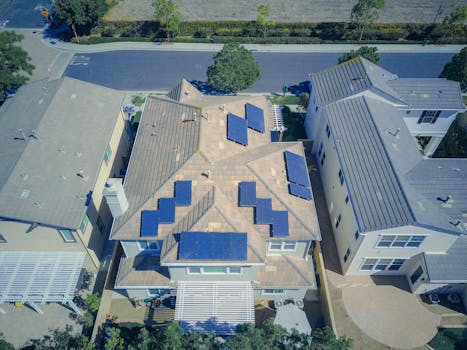“Solar Mounting Systems: Harnessing Energy While Protecting Our Planet.”
The environmental impact of solar mounting systems is a critical consideration in the broader context of renewable energy development. As the demand for solar energy continues to rise, understanding how these systems affect ecosystems, land use, and resource consumption becomes essential. Solar mounting systems, which support photovoltaic panels, can influence soil health, water runoff, and local wildlife habitats. Additionally, the materials used in these systems, their manufacturing processes, and end-of-life disposal contribute to their overall environmental footprint. This introduction aims to highlight key factors related to the environmental implications of solar mounting systems, providing insights into sustainable practices and potential mitigation strategies for minimizing negative impacts while maximizing the benefits of solar energy.
Carbon Footprint Reduction of Solar Mounting Systems
The environmental impact of solar mounting systems is a crucial aspect to consider when evaluating the overall sustainability of solar energy. One of the most significant benefits of these systems is their potential to reduce carbon footprints, which is increasingly important in the context of global climate change. Solar mounting systems, which are essential for securing solar panels in place, play a pivotal role in harnessing solar energy efficiently. By facilitating the installation of solar panels, these systems contribute to the generation of clean energy, thereby displacing the need for fossil fuels that are responsible for greenhouse gas emissions.
When solar panels are installed on mounting systems, they can generate electricity without emitting carbon dioxide or other harmful pollutants. This clean energy production is vital in combating climate change, as it directly reduces reliance on traditional energy sources that contribute to global warming. The transition from fossil fuels to renewable energy sources like solar power is a key strategy in achieving carbon neutrality. Consequently, the installation of solar mounting systems is not merely a technical necessity; it is an integral part of a broader movement towards sustainable energy solutions.
Moreover, the materials used in solar mounting systems also play a role in their environmental impact. Many modern mounting systems are designed with sustainability in mind, utilizing recycled or recyclable materials that minimize resource extraction and waste. For instance, aluminum and steel, commonly used in these systems, can be recycled multiple times without losing their structural integrity. This characteristic not only reduces the carbon footprint associated with the production of new materials but also promotes a circular economy, where resources are reused rather than discarded.
In addition to the materials, the manufacturing processes of solar mounting systems have evolved to become more energy-efficient. Manufacturers are increasingly adopting practices that reduce energy consumption and emissions during production. By optimizing manufacturing techniques and utilizing renewable energy sources in their operations, companies can significantly lower the carbon footprint associated with the production of solar mounting systems. This shift towards greener manufacturing practices further enhances the overall sustainability of solar energy systems.
Furthermore, the installation of solar mounting systems can lead to long-term carbon footprint reductions. Once installed, solar panels can operate for 25 years or more, continuously generating clean energy throughout their lifespan. This longevity means that the initial carbon emissions associated with the production and installation of the mounting systems are offset by the substantial amount of clean energy produced over time. In essence, the environmental benefits of solar mounting systems extend far beyond their immediate use; they contribute to a significant reduction in carbon emissions over their operational lifetime.
In conclusion, the carbon footprint reduction associated with solar mounting systems is a vital component of their environmental impact. By facilitating the efficient installation of solar panels, these systems enable the generation of clean energy, thereby displacing fossil fuel use and reducing greenhouse gas emissions. The sustainable materials and energy-efficient manufacturing processes further enhance their positive environmental contributions. As the world continues to grapple with the challenges of climate change, understanding the role of solar mounting systems in reducing carbon footprints becomes increasingly important. Embracing these technologies not only supports the transition to renewable energy but also fosters a more sustainable future for generations to come.
Land Use Considerations for Solar Installations
As the demand for renewable energy sources continues to rise, solar power has emerged as a leading alternative to fossil fuels. However, the environmental impact of solar installations extends beyond the energy they produce; it also encompasses the land use considerations associated with solar mounting systems. Understanding these implications is crucial for stakeholders, including policymakers, developers, and communities, as they navigate the balance between harnessing solar energy and preserving natural habitats.
When planning solar installations, one of the primary concerns is the amount of land required for solar panels and associated infrastructure. Large-scale solar farms can occupy significant tracts of land, which may lead to habitat disruption and loss of biodiversity. This is particularly concerning in areas where solar installations are sited on previously undeveloped land, such as grasslands, forests, or wetlands. The conversion of these ecosystems into solar farms can result in the displacement of native species and the alteration of local ecosystems. Therefore, it is essential to conduct thorough environmental assessments before proceeding with solar projects to identify potential impacts and develop strategies to mitigate them.
In contrast, utilizing previously disturbed or degraded land for solar installations can offer a more sustainable solution. Brownfields, abandoned industrial sites, and rooftops of commercial buildings present opportunities for solar development without further encroaching on natural habitats. By prioritizing these areas, developers can minimize the ecological footprint of solar energy projects while simultaneously revitalizing underutilized spaces. This approach not only helps preserve biodiversity but also contributes to urban renewal and economic development.
Moreover, the design and layout of solar mounting systems can significantly influence land use impacts. Innovative mounting technologies, such as agrivoltaics, allow for the dual use of land by combining agriculture and solar energy production. This method enables farmers to grow crops beneath solar panels, thereby maximizing land efficiency and providing additional income streams. By integrating solar installations into agricultural landscapes, stakeholders can promote sustainable land use practices that benefit both energy production and food security.
Another important consideration is the potential for solar installations to contribute to land degradation if not managed properly. Soil erosion, compaction, and changes in hydrology can occur as a result of construction activities and the long-term presence of solar infrastructure. To mitigate these risks, developers should implement best management practices, such as maintaining vegetation cover, using permeable materials, and designing effective drainage systems. These measures can help preserve soil health and prevent adverse environmental impacts.
Furthermore, community engagement plays a vital role in addressing land use concerns associated with solar installations. Involving local stakeholders in the planning process can lead to more informed decision-making and foster a sense of ownership over renewable energy projects. By considering community needs and values, developers can identify suitable sites for solar installations that align with local priorities, ultimately enhancing public support for renewable energy initiatives.
In conclusion, while solar mounting systems offer a promising solution to the challenges of climate change and energy sustainability, their environmental impact cannot be overlooked. By carefully considering land use implications, prioritizing previously disturbed areas, employing innovative technologies, and engaging with communities, stakeholders can ensure that solar energy development proceeds in an environmentally responsible manner. As the transition to renewable energy continues, it is imperative to strike a balance between harnessing solar power and protecting the natural landscapes that are vital to our planet’s health.
Recycling and Sustainability of Solar Mounting Materials
As the world increasingly turns to renewable energy sources, solar power has emerged as a leading solution to combat climate change and reduce reliance on fossil fuels. However, the environmental impact of solar energy extends beyond the panels themselves; it also encompasses the materials used in solar mounting systems. Understanding the recycling and sustainability of these materials is crucial for assessing the overall ecological footprint of solar energy installations.
Solar mounting systems, which are essential for securing solar panels to rooftops or the ground, are typically made from metals such as aluminum and steel, as well as various types of plastics. These materials are chosen for their durability and resistance to environmental factors, ensuring that solar installations can withstand harsh weather conditions over their operational lifespan. However, the sustainability of these materials is a pressing concern, particularly when considering their end-of-life scenarios.
Recycling plays a pivotal role in mitigating the environmental impact of solar mounting systems. Aluminum, for instance, is one of the most recyclable materials on the planet. The recycling process for aluminum requires only a fraction of the energy needed to produce new aluminum from raw materials, significantly reducing greenhouse gas emissions. Furthermore, recycled aluminum retains its properties, making it a viable option for producing new mounting systems or other products. This closed-loop system not only conserves resources but also minimizes waste, contributing to a more sustainable approach to solar energy infrastructure.
Similarly, steel is another material commonly used in solar mounting systems that can be effectively recycled. The recycling rate for steel is remarkably high, with a significant percentage of steel products being made from recycled content. This not only reduces the demand for virgin materials but also lessens the environmental impact associated with mining and processing new steel. By prioritizing the use of recycled steel in solar mounting systems, manufacturers can further enhance the sustainability of solar energy installations.
In addition to metals, the plastics used in solar mounting systems also warrant attention. While plastics are often viewed as less sustainable due to their long decomposition times, advancements in recycling technologies are paving the way for more effective solutions. Some companies are exploring the use of biodegradable plastics or developing methods to recycle traditional plastics into new products. As the industry evolves, it is essential for stakeholders to prioritize the use of sustainable materials and support innovations that enhance the recyclability of plastics used in solar mounting systems.
Moreover, the lifecycle assessment of solar mounting systems is crucial for understanding their overall environmental impact. This assessment evaluates the energy and resources consumed during the production, installation, operation, and disposal of these systems. By adopting a circular economy approach, where materials are reused and recycled rather than discarded, the solar industry can significantly reduce its ecological footprint. This not only benefits the environment but also aligns with the growing consumer demand for sustainable practices.
In conclusion, the recycling and sustainability of solar mounting materials are integral components of the broader conversation surrounding solar energy’s environmental impact. By focusing on the recyclability of metals like aluminum and steel, as well as exploring innovative solutions for plastics, the solar industry can enhance its sustainability profile. As we continue to embrace renewable energy sources, it is imperative to consider the entire lifecycle of solar installations, ensuring that they contribute positively to our planet’s health and future.
Wildlife Habitat Preservation in Solar Projects
The environmental impact of solar mounting systems extends beyond their role in harnessing renewable energy; it also encompasses the critical aspect of wildlife habitat preservation. As the demand for solar energy continues to rise, the integration of solar projects into various landscapes necessitates a careful examination of their effects on local ecosystems. Understanding how solar mounting systems can either support or hinder wildlife habitats is essential for developing sustainable energy solutions.
When solar farms are established, they often occupy large tracts of land, which can disrupt existing wildlife habitats. However, with thoughtful planning and design, solar projects can be implemented in ways that minimize ecological disruption. For instance, selecting sites that are already degraded or previously developed can significantly reduce the impact on pristine habitats. By prioritizing these areas, developers can help preserve vital ecosystems while still contributing to the renewable energy landscape.
Moreover, the design of solar mounting systems can play a pivotal role in wildlife preservation. Elevated solar panels, for example, can create shaded areas beneath them, which can serve as habitats for various species, including small mammals and ground-nesting birds. This innovative approach not only maximizes land use but also fosters biodiversity by providing shelter and foraging opportunities for wildlife. Additionally, incorporating native vegetation around solar installations can further enhance habitat quality, offering food sources and nesting sites for local fauna.
Incorporating wildlife-friendly practices into solar project planning is not merely a matter of environmental ethics; it is also a regulatory requirement in many regions. Environmental impact assessments (EIAs) are often mandated before the approval of solar projects, ensuring that potential effects on local wildlife are thoroughly evaluated. These assessments can lead to the implementation of mitigation strategies, such as creating wildlife corridors or buffer zones, which help maintain connectivity between habitats. By adhering to these guidelines, solar developers can contribute to the preservation of biodiversity while advancing renewable energy goals.
Furthermore, community engagement plays a crucial role in wildlife habitat preservation within solar projects. Involving local stakeholders, including conservation organizations and wildlife experts, can provide valuable insights into the specific needs of the ecosystem. This collaborative approach not only fosters transparency but also encourages the adoption of best practices that align with both energy production and wildlife conservation. By working together, developers and communities can create solar projects that are not only efficient but also ecologically responsible.
As the solar industry continues to evolve, the integration of advanced technologies can further enhance wildlife habitat preservation. For instance, the use of drones and remote sensing can aid in monitoring wildlife populations and assessing habitat conditions around solar installations. This data-driven approach allows for adaptive management strategies that can be implemented in real-time, ensuring that any negative impacts on wildlife are promptly addressed.
In conclusion, the environmental impact of solar mounting systems on wildlife habitats is a multifaceted issue that requires careful consideration and proactive measures. By prioritizing site selection, employing innovative design strategies, adhering to regulatory requirements, engaging with local communities, and leveraging technology, solar projects can effectively balance energy production with the preservation of vital ecosystems. As we move towards a more sustainable future, it is imperative that we recognize the interconnectedness of renewable energy and wildlife conservation, ensuring that our pursuit of clean energy does not come at the expense of the natural world.
Q&A
1. **What are the primary environmental benefits of solar mounting systems?**
Solar mounting systems facilitate the installation of solar panels, which generate clean, renewable energy, reducing reliance on fossil fuels and lowering greenhouse gas emissions.
2. **What are the potential environmental drawbacks of solar mounting systems?**
The production and installation of solar mounting systems can involve the use of materials and processes that may contribute to habitat disruption, resource depletion, and pollution if not managed sustainably.
3. **How do solar mounting systems affect land use?**
Solar mounting systems can require significant land area, which may lead to land use changes, habitat loss, and impacts on local ecosystems, particularly in large-scale solar farms.
4. **What measures can be taken to minimize the environmental impact of solar mounting systems?**
Implementing sustainable sourcing of materials, optimizing land use through dual-use systems (e.g., agrivoltaics), and ensuring proper recycling and disposal of components can help mitigate environmental impacts.
Conclusion
The environmental impact of solar mounting systems is significant, as they play a crucial role in the overall sustainability of solar energy installations. While they facilitate the efficient harnessing of solar power, considerations such as land use, material sourcing, and end-of-life disposal are essential. Properly designed and implemented solar mounting systems can minimize ecological disruption, promote biodiversity, and reduce carbon footprints. Ultimately, understanding these factors is vital for optimizing the environmental benefits of solar energy and ensuring that solar installations contribute positively to ecological health.




